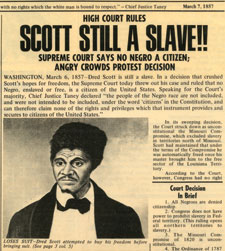On March 6 1857, the Supreme court decided that any African Americans either slave or free were not American citizens and therefore could not pursue legal matters in court. Moreover, the court found that Congress did not have the ability to abolish slavery and that slave owners ownership on slaves was protected by the 5th amendment. Collectively, this came from Scott v. Sandford, where widowed Eliza Sanford refused to let Scott buy his freedom despite formerly living in a free state, causing a lawsuit. Justice Taney ruled that this case would not be considered and due to this, tensions furthered between North and South grew.
 |
| Dred Scott Decision |
 |
| Brown v. Board of education was very similar to this ruling |


Comments
Post a Comment